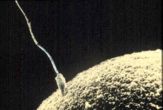
Sperm are a lively bunch to begin with, but they become even more excited when they zero in on an egg. They swim faster and their tail movements become more forceful and erratic.
Now scientists have linked this behavior, called "hyperactivity," to selective protein channels in the sperm's tail.
The results are detailed in the Feb. 9 issue of the journal Nature.
Breaking through
Sperm hyperactivity is necessary for breaking through two physical barriers that protect the egg from fertilization.
The current study links two key findings made in recent years about sperm hyperactivity. The first was that a sperm's whip-like tail is studded with selective channels made from a protein called CatSper1 that allows only calcium ions through. Scientists also knew that hyperactivity was associated with sudden influxes of calcium into the tails.
A sperm's tail is called a flagellum, and it spins like a boat propeller to move the sperm forward.
Sign up for the Live Science daily newsletter now
Get the world’s most fascinating discoveries delivered straight to your inbox.
Using a cellular recording technique called patch-clamping, the researchers established definitively that the opening of CatSper1 is responsible for the influx of calcium into the sperm. The calcium surge causes the sperm's tail to spin faster and more unevenly and the sperm is propelled through its viscous environment more forcefully.
In experiments involving mice, the researchers showed that sperm lacking CatSper1 can't achieve the hyperactive state they need for egg fertilization.
Storming the fort
The first barrier to sperm is made up of so-called cumulus cells that encase the egg like chain mail.
The second barrier is a membrane called the zona pellucida. One of the proteins that make up the zona pellucida binds to a partner molecule on the sperm. This lock-and-key type mechanism is species-specific and prevents the sperm and egg of different species from getting together.
Once a sperm reaches an egg's zona pellucida, it can partly dissolve the membrane with special enzymes. But the enzymes aren't enough for the sperm to completely break through and fuse with the egg.
"If the sperm aren't hyperactiviated by the time they reach the zona pellucida, they wouldn't be able to break through," said study team member Yuriy Kirichok from Harvard Medical School. "They need both enzymes and hyperactivity."
Knowing all this suggests the proteins are good targets for contraception.
"We know that defects in CatSper1 block fertilization in mice," said study leader David E. Clapham of the Howard Hughes Medical Institute. "And since the channels in human sperm are very similar, there's no reason to believe you couldn't develop a male or female birth control pill that would block the protein before it functions to hyperactivate sperm, preventing fertilization."
- Sperm Cells Swim in Circles
- Stem Cells in Lab Make Sperm
- Survival Skills: Why Sex is Good
- Scientists Plan to Craft Embryo from Two Women
- Sperm Cells Turned into Eggs
Sperm Facts
A single human male ejaculation releases about half a teaspoonful ( 2.75 ml) of semen containing anywhere between 180 to 400 million sperm.
If this number falls below about 20 million sperm, a man is considered clinically infertile.
A single sperm is about 40 microns (0.0016 inches) long and carries 23 chromosomes. Sperm swim at about 30 inches per hour and can survive in the female reproductive tract for up to three days.
Credit: Charles Lindemann/Oakland University









